(完整word版)2018-2019学年第二学期浙江省高三“五校联考”英语试题
浙江省名校协作体2019届高三第二学期联考英语试题
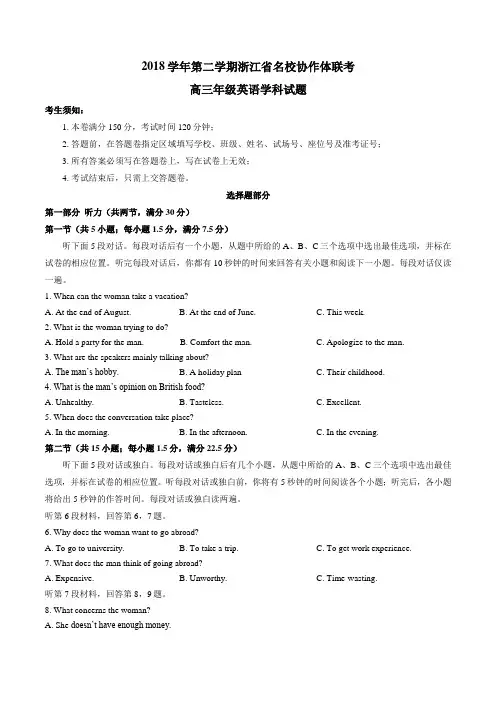
2018学年第二学期浙江省名校协作体联考高三年级英语学科试题考生须知:1. 本卷满分150分,考试时间120分钟;2. 答题前,在答题卷指定区域填写学校、班级、姓名、试场号、座位号及准考证号;3. 所有答案必须写在答题卷上,写在试卷上无效;4. 考试结束后,只需上交答题卷。
选择题部分第一部分听力(共两节,满分30分)第一节(共5小题;每小题1.5分,满分7.5分)听下面5段对话。
每段对话后有一个小题,从题中所给的A、B、C三个选项中选出最佳选项,并标在试卷的相应位置。
听完每段对话后,你都有10秒钟的时间来回答有关小题和阅读下一小题。
每段对话仅读一遍。
1. When can the woman take a vacation?A. At the end of August.B. At the end of June.C. This week.2. What is the woman trying to do?A. Hold a party for the man.B. Comfort the man.C. Apologize to the man.3. What are the speakers mainly talking about?A. The man’s hobby.B. A holiday planC. Their childhood.4. What is the man’s opinion on British food?A. Unhealthy.B. Tasteless.C. Excellent.5. When does the conversation take place?A. In the morning.B. In the afternoon.C. In the evening.第二节(共15小题;每小题1.5分,满分22.5分)听下面5段对话或独白。
每段对话或独白后有几个小题,从题中所给的A、B、C三个选项中选出最佳选项,并标在试卷的相应位置。
浙江省2019届高三下学期五校联考试题 英语 PDF版答案
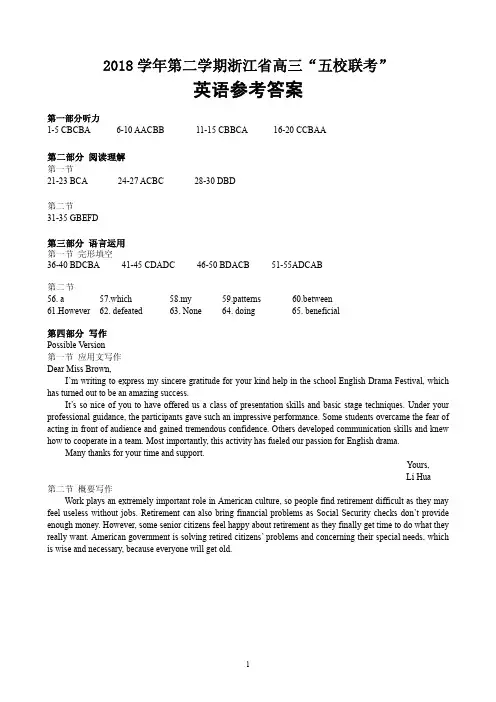
2018学年第二学期浙江省高三“五校联考”英语参考答案第一部分听力1-5 CBCBA 6-10 AACBB 11-15 CBBCA 16-20 CCBAA第二部分阅读理解第一节21-23 BCA 24-27 ACBC 28-30 DBD第二节31-35 GBEFD第三部分语言运用第一节完形填空36-40 BDCBA 41-45 CDADC 46-50 BDACB 51-55ADCAB第二节58.my 59.patterns 60.betweena 57.which56.64.beneficial65.doing61.However 62.defeated 63.None第四部分写作Possible Version第一节应用文写作Dear Miss Brown,I’m writing to express my sincere gratitude for your kind help in the school English Drama Festival, which has turned out to be an amazing success.It’s so nice of you to have offered us a class of presentation skills and basic stage techniques. Under your professional guidance, the participants gave such an impressive performance. Some students overcame the fear of acting in front of audience and gained tremendous confidence. Others developed communication skills and knew how to cooperate in a team. Most importantly, this activity has fueled our passion for English drama.Many thanks for your time and support.Yours,Li Hua第二节概要写作Work plays an extremely important role in American culture, so people find retirement difficult as they may feel useless without jobs. Retirement can also bring financial problems as Social Security checks don’t provide enough money. However, some senior citizens feel happy about retirement as they finally get time to do what they really want. American government is solving retired citizens’ problems and concerning their special needs, which is wise and necessary, because everyone will get old.Text 1W: Are you busy this week?M: Not particularly. I’m reviewing my lessons until Wednesday because I’ve got an exam, but that only lasts until midday and then I’m free.Text 2M: Sue, how did you do?W: The paper is tough. I hope Mr. Smith won’t fail me.M: Oh, don’t worry. I’m sure it is not that bad.W: I should have studied harder.Text 3M: Many countries have high-speed rail transportation.W: So has Japan. The trains move rapidly from one city to another, saving a lot of time.M: That’s true, but I’m afraid modern travel does not allow us to relax and enjoy the trip.Text 4W: I’m not keen on fried food myself. I’d rather have some vegetables and fruits.M: Yes. I notice you always eat the greens, but meat has some special vitamins too.W: I know, but I must watch my weight, you know.M: I see, so you can’t have the taste of fried chicken.Text 5M: Hello, Mary, this is John Smith from the bank. Is Paul there?W: Not yet. He phoned me from the office 5 minutes ago to say that he was going to look for a birthday present on his way home.Text 6M: Can you tell me how to reach the bank?W: Which bank? There are two: the Allied Irish Bank and the Bank of Ireland.M: I have an ATB pass card and I want to get some money from the bank.W: You need to go to the Allied Bank which is near the local shopping center, Dunnes Stores.M: How do I get there? I have no knowledge of this area.W: Cross the road and turn left at the other side. Walk along the footpath until you reach the traffic lights. You will see a shopping center on the right hand side. Walk across the road and turn right after the shopping center. Keep going straight for about 100 meters and the bank is to your left.M: It sounds a little bit so difficult. It’s about five minutes’ walk from here. I can draw a map for you if you wish. M: Oh, I would really appreciate that.Text 7W: Wake up, Erik, time to rise and shine.M: Ha, oh, hi, Jane, I must have fallen asleep while I was reading.W: You and everyone else. It looks more like a campground than a library.M: Well, the classroom’s too noisy to study in and I guess this place is too quiet.W: Have you had any luck finding a topic for your paper?M: No, Professor Grant told us to write about anything on Eastern culture. For once I wish she had not given us so much of a choice.W: Well, why not write about Chinese culture? You seem to be interested in that part of the world.M: I am, but there is too much material to cover. I’ll be writing forever, and Professor Grant only wants five to seven pages.W: So then limit it to one place in China, say Beijing. You’ve been there and you said it’s got lots of places of interest and you enjoyed your trip very much.M: That’s not a bad idea. I brought many books and things back with me last summer. That would be great resource material, now if I can remember only where I put them.Text 8M: I’m sorry about the accident, Mrs. Norris.W: No one was hurt, thank goodness.M: We need to send in an accident report. And I need to ask you a few questions.W: All right.M: Where exactly was the accident?W: It was on Jefferson Street, between 19th and 20th Streets.M: What time did it happen?W: At five minutes after five.M: And who hit you?W: Her name is Mrs. William R Crauston. She lives at 1645 Jefferson Street.M: Now, what happed exactly? Tell me in your own words.W: Well, I was driving along Jefferson Street. I wasn’t going fast at all. I saw this car. It was backing out of the driveway. It was Mrs. Crouston. She didn’t stop at all. She backed right into me.M: Very well. Now I need to look at your car. Where is it?W: It’s at Fulton’s Garage. That’s on Jefferson and Vine Streets. I’ll go along with you.Text 9W: Dr. Brown, you are working with the UN Food and Agriculture Organization. Would you please tell our listeners something about diseases recently spreading among animals?M: Well animal diseases were reported recently in the Middle East, Africa and Europe. The UN officials give two reasons for animal diseases spreading. One is the increased international trade in animals and animal products. The other is the movement of people and animals from country to country.W: How can we prevent and treat animal diseases?M: Well, no country can claim to be safe from animal diseases. Medical care of animals is very important.W: Do animal diseases kill human beings?M: Yes. It was reported that Rift Valley Fever killed 30 people in Yemen last month.W: How about the other animal diseases?M: Earlier this year, Italy reported outbreaks of bluetongue. Last month, foot-and-mouth disease was reported in South Africa. In just one month, 36,000 head of cattle were killed to control the disease.Text 10M: Welcome to Morning News. “Go to the playground and have fun,” parents will often say to their kids. But they should remember playgrounds can be dangerous. Each year about 200,000 children end up in hospital emergency rooms with playground injuries. Many injuries involve falls from too high equipment on too hard surfaces. Nearly 70% of the injuries happen on public playgrounds. Recent studies show they may be badly designed, their protective surfaces are inadequate, and their equipment is poorly maintained. Parents should make sure that the equipment in the playground is safe and the children are playing safely. Last year, the national program for playground safety gave the nation’s playgrounds a grade of C for safety after visiting more than 3,000 playgrounds nationwide. Parents should watch closely. They should always be within shouting and running distance of their children. Young children don’t understand cause and effect. So they may run in front of moving swings. They’re also better at climbing up than at getting down. So they may panic at the top of a ladder. It’s important for children to know you’re watching them. Once they feel that sense of security, that’s when they can be creative.。
2019届浙江三校联盟考试高三5月模拟英语试题 (含听力)
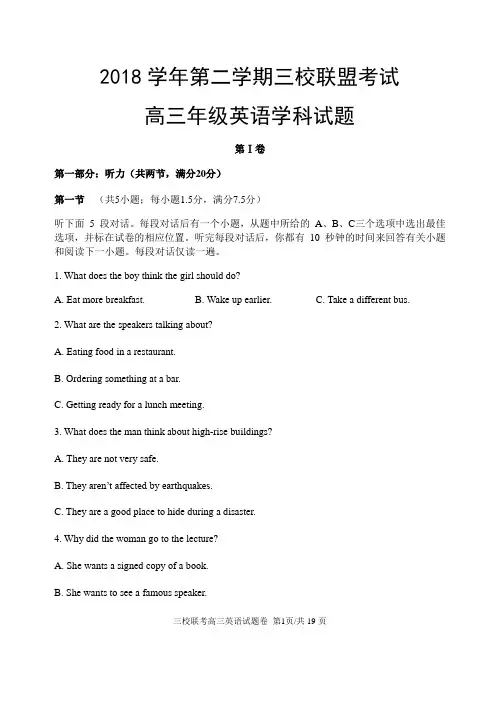
2018学年第二学期三校联盟考试高三年级英语学科试题第Ⅰ卷第一部分:听力(共两节,满分20分)第一节(共5小题;每小题1.5分,满分7.5分)听下面5 段对话。
每段对话后有一个小题,从题中所给的A、B、C三个选项中选出最佳选项,并标在试卷的相应位置。
听完每段对话后,你都有10 秒钟的时间来回答有关小题和阅读下一小题。
每段对话仅读一遍。
1. What does the boy think the girl should do?A. Eat more breakfast.B. Wake up earlier.C. Take a different bus.2. What are the speakers talking about?A. Eating food in a restaurant.B. Ordering something at a bar.C. Getting ready for a lunch meeting.3. What does the man think about high-rise buildings?A. They are not very safe.B. They aren’t affected by earthquakes.C. They are a good place to hide during a disaster.4. Why did the woman go to the lecture?A. She wants a signed copy of a book.B. She wants to see a famous speaker.三校联考高三英语试题卷第1页/共19页C. She heard they would give away T-shirts.5. Where does the conversation take place?A. At a car rental company.B. At an insurance company.C. In a gas station.第二节(共15小题;每小题1.5分,满分22.5分)听下面5段对话或独白。
精品解析:浙江省名校协作体2019届高三第二学期联考英语试题(含听力)(解析版)
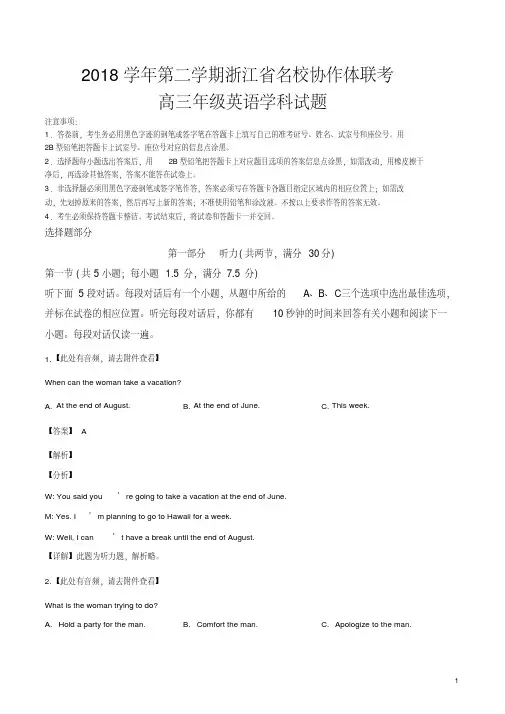
第一部分 听力 ( 共两节,满分 30 分)
第一节 ( 共 5 小题;每小题 1.5 分,满分 7.5 分)
听下面 5 段对话。每段对话后有一个小题,从题中所给的 A、B、 C三个选项中选出最佳选项,
并标在试卷的相应位置。听完每段对话后,你都有 10 秒钟的时间来回答有关小题和阅读下一
小题。每段对话仅读一遍。
What are the speakers mainly talking about?
A. The man’s hobby.
B. A holiday plan
C. Their childhood.
【答案】 A
【解析】 【分析】 W: Did you like photography when you were a child? M: Yes. I have been interested in it since the age of nine. For me, a holiday is always about exploration — about finding beauty and the unknown and taking photos of them. 【详解】此题为听力题,解析略。
2018 学年第二学期浙江省名校协作体联考 高三年级英语学科试题
注意事项: 1 .答卷前,考生务必用黑色字迹的钢笔或签字笔在答题卡上填写自己的准考证号、姓名、试室号和座位号。用 2B 型铅笔把答题卡上试室号、座位号对应的信息点涂黑。 2.选择题每小题选出答案后,用 2B 型铅笔把答题卡上对应题目选项的答案信息点涂黑,如需改动,用橡皮擦干 净后,再选涂其他答案,答案不能答在试卷上。 3 .非选择题必须用黑色字迹钢笔或签字笔作答,答案必须写在答题卡各题目指定区域内的相应位置上;如需改 动,先划掉原来的答案,然后再写上新的答案;不准使用铅笔和涂改液。不按以上要求作答的答案无效。 4 .考生必须保持答题卡整洁。考试结束后,将试卷和答题卡一并交回。
2019年5月浙江三校联盟考试高三英语试题(含答案)
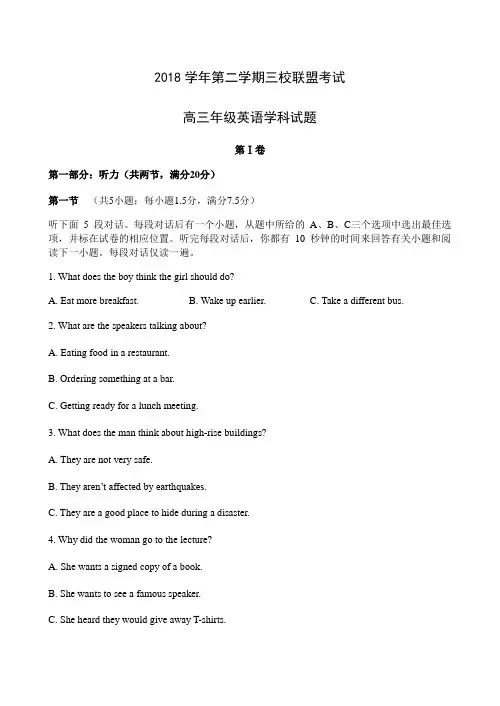
2018学年第二学期三校联盟考试高三年级英语学科试题第Ⅰ卷第一部分:听力(共两节,满分20分)第一节(共5小题;每小题1.5分,满分7.5分)听下面5 段对话。
每段对话后有一个小题,从题中所给的A、B、C三个选项中选出最佳选项,并标在试卷的相应位置。
听完每段对话后,你都有10 秒钟的时间来回答有关小题和阅读下一小题。
每段对话仅读一遍。
1. What does the boy think the girl should do?A. Eat more breakfast.B. Wake up earlier.C. Take a different bus.2. What are the speakers talking about?A. Eating food in a restaurant.B. Ordering something at a bar.C. Getting ready for a lunch meeting.3. What does the man think about high-rise buildings?A. They are not very safe.B. They aren’t affected by earthquakes.C. They are a good place to hide during a disaster.4. Why did the woman go to the lecture?A. She wants a signed copy of a book.B. She wants to see a famous speaker.C. She heard they would give away T-shirts.5. Where does the conversation take place?A. At a car rental company.B. At an insurance company.C. In a gas station.第二节(共15小题;每小题1.5分,满分22.5分)听下面5段对话或独白。
浙江省名校协作体2019届高三第二学期联考英语试题
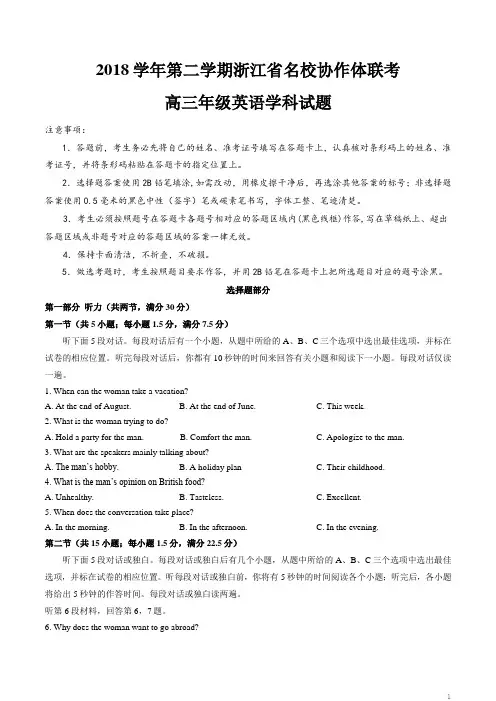
2018学年第二学期浙江省名校协作体联考高三年级英语学科试题注意事项:1.答题前,考生务必先将自己的姓名、准考证号填写在答题卡上,认真核对条形码上的姓名、准考证号,并将条形码粘贴在答题卡的指定位置上。
2.选择题答案使用2B铅笔填涂,如需改动,用橡皮擦干净后,再选涂其他答案的标号;非选择题答案使用0.5毫米的黑色中性(签字)笔或碳素笔书写,字体工整、笔迹清楚。
3.考生必须按照题号在答题卡各题号相对应的答题区域内(黑色线框)作答,写在草稿纸上、超出答题区域或非题号对应的答题区域的答案一律无效。
4.保持卡面清洁,不折叠,不破损。
5.做选考题时,考生按照题目要求作答,并用2B铅笔在答题卡上把所选题目对应的题号涂黑。
选择题部分第一部分听力(共两节,满分30分)第一节(共5小题;每小题1.5分,满分7.5分)听下面5段对话。
每段对话后有一个小题,从题中所给的A、B、C三个选项中选出最佳选项,并标在试卷的相应位置。
听完每段对话后,你都有10秒钟的时间来回答有关小题和阅读下一小题。
每段对话仅读一遍。
1. When can the woman take a vacation?A. At the end of August.B. At the end of June.C. This week.2. What is the woman trying to do?A. Hold a party for the man.B. Comfort the man.C. Apologize to the man.3. What are the speakers mainly talking about?A. The man’s hobby.B. A holiday planC. Their childhood.4. What is the man’s opinion on British food?A. Unhealthy.B. Tasteless.C. Excellent.5. When does the conversation take place?A. In the morning.B. In the afternoon.C. In the evening.第二节(共15小题;每小题1.5分,满分22.5分)听下面5段对话或独白。
2019学年浙江省高三“五校联考”第二次考试英语试题卷(含答案)
浙江省高三“五校联考”第二次考试英语试题卷命题学校:杭州学军中学第I卷第一部分:听力(共两节,满分30分)第一节(共5 小题;每小题 1.5 分,满分7.5 分)听下面5 段对话。
每段对话后有一个小题,从题中所给A、B、C 三个选项中选出最佳选项,并标在试卷相应位置。
听完每段对话后,你都有10 秒钟时间来回答有关小题和阅读下一小题。
每段对话仅读一遍。
1. What does the woman mean?A. She wants the man to help her.B. The maths puzzle is also difficult for her.C. It’s a pity for the man not to solve the puzzle.2. What will the woman probably do with the computer?A. Have it checked.B. Have it replaced.C. Have it returned to the store.3. What are the two speakers mainly talking about?A. Housework.B. Windows.C. Noise.4. What probably is the woman?A. A hotel clerk.B. A bank clerk.C. A restaurant manager.5. Why does the woman come to the man’s office?A. To invite him to have lunch.B. To work together with the man.C. To talk to him about her paper.第二节(共15 小题;每小题 1.5 分,满分22.5 分)听下面5段对话或独白。
2018年浙江高三二模英语试卷(五校联考)-学生用卷
2018年浙江高三二模英语试卷(五校联考)-学生用卷一、阅读理解1、【来源】 2018年浙江高三二模(A篇)第21~24题10分Ruhani Ahluwalia is a tenth-grade student at Harmony School of Innovation, a public charter school in southwest Fort Worth. Since age 11, the teenager has been working summers in a lab at the University of North Texas Health Science Center researching cancer cells. She is testing drugs that can kill cancer cells while limiting the side effects to healthy cells."The tragic death of my great-aunt, who suffered frown leukemia(白血病)for 13 years, inspired me to research possible cancer treatments, " Ahluwalia explained in one written description of her research. "What ended up really damaging her was the chemotherapy(化疗)and the effects of it because chemotherapy kills both cancer and normal cells." Because of this, Ahluwalia said most of her great aunt's body broke down as she battled cancer.During the summer between sixth and seventh grade, Ahluwalia began research with the help of her mother, Jodhka, a microbiology professor, who taught her the necessary biology. Ahluwalia said she had to learn everything outside of school. Guided by her mother, she was able to start working in a university research lab, Ahluwalia spent her recent summer vacations in the lab working from about 10 a. m. to 3 p. m. She has presented her findings at multiple science fairs.Ahluwalia hasn't decided what she plans to study in the future, but she knows whatever it is, it will build on her enthusiasm. Her current challenge is TAL#NBSP juggling schoolwork with her interest because apart from cancer research, she has to work on projects and study for tests. "I like learning, "" she said. "I don't like studying. There is a difference between the two. Studying is caught up in finishing it, in turning it in, and in making the teacher happy. Learning is doing more for yourself."(1) Why did Ahluwalia start cancer research?A. Because she lost her great-aunt to cancer.B. Because she was influenced by her mother.C. Because she intended to help her great-aunt fight cancer.D. Because she wanted to ease her great-aunt's pain of chemotherapy.(2) What role does Jodhka play in Ahluwalia's research?A. The monitor.B. The partner.C. The organized.D. The instructor.(3) What does the underlined word "juggling" mean in Paragraph 4?A. Matching.B. Associating.C. Balancing.D. Comparing.(4) Which words can best describe Ahluwalia?A. Hard-working and intelligent.B. Helpful and responsible.C. Independent and thoughtful.D. Creative and honest.2、【来源】 2018年浙江高三二模(B篇)第25~27题6分Inside The Walt Disney Studios' original animation building, where artists once drew "Cinderella" by hand, a 15-person team of innovators(创新者)is trying to create a movie making lab. Instead of pencils and light tables, in the 3, 500-square-foot innovation center, StudioLAB, visitors find experimental virtual (虚拟的)reality editing equipment, drones(无人遥控飞机)and digital projections around walls.The purpose of the lab is to use Silicon Valley-style experimentation to help studio executives and filmmakers stay ahead of rapid advances in technology by developing and showcasing new ideas for making and marketing movies.Studio technology centers are hardly a new idea. 20th Century Fox, for example, founded its own Fox Innovation Lab in 2014, and Sony Pictures in June, 2018, announced its Innovation Studios project in Culver City. Disney executive said their center can succeed by combining the brain power of their various studios, including Marvel Studios, Pixar and Lucasfilm. "We needed to push our own industry forward, " said Jamie Voris, the Studios' chief technology officer. "By pulling together, we can solve these big and complex problems."StudioLAB also wants to improve the filmmaking process itself. It released a piece of software called Scout-in-a-Box that uses drones to view and digit ally re-create filming locations. It used videoconferencing technology so that workers at the lab were able to see and interact with the actors and crew remotely and get a detailed sense of the filming process.Disney also wants the lab to address major long-term challenge. For example, the lab is working on ways to improve data security in a cheaper and more efficient way. Although some of the ideas remain in early stages, Benjamin Havey, vice president of Disney's Technology Innovation Group, is convinced that more of the lab's experiments will find practical uses. "I'm happy when innovations get out of the lab and into the real world, " he said. "That's what I live for."(1) What is special about StudioLAB?A. It reduced costs of film making.B. It enabled different studios to communicate.C. It provided new filming locations.D. It applies high technology to filmmaking.(2) What can be inferred from Paragraph 3?A. Fox's studio technology is ahead of Disney's.B. Different studios of Disney unite in better films.C. StudioLAB has strong links with Sony's and Fox's labs.D. Film companies have generally set up technology centers.(3) What's Benjamin Havey's attitude to StudioLAB's future?A. Worried.B. Ambiguous.C. Hopeful.D. Negative.3、【来源】 2018年浙江高三二模(C篇)第28~30题7.5分For the first time in the Pew Research Center' history, social media have replaced print newspapers as Americans' main news source, with 20 percent of adults surveyed reporting they rely on social media for the latest up dates. In contrast, just 16 percent consider print newspapers as their most frequented medium.These findings reflect the much-discussed decline of print media, as well as the rise of digital news source. Still, Pew's researcher Elisa Shearer notes that television remains dominant(占优势的)across all mediums, with 49 percent of respondents—downs percent from 2016—reporting they learn the news mainly by watching local, cable and network news shows. News website finish second overall, claimingthe attention of 33 percent of Americans, an increase of 5 percent since 2016. Radio comes in third at 26 percent, followed by social media and, lastly, print newspapers.Pew' director of journalism research, Amy Mitchell, write that the new findings, which are based on a survey of 3, 425 U.S. adults conducted between July 30 and August 12, 2018, point toward Americans' preference for watching rather than reading or listening to the news. Television remains the preferred viewing platform among watchers, but a growing minority(20 percent)say they prefer streaming news videos online.Unsurprisingly, consumption habits varied dramatically according to age. About 80 percent of individuals 65 and older regard television as their most frequented news source, compared to just 16 percent of those aged 18 to 29 and 36 percent of those aged 30 to 49.Younger Americans also tend to draw on a variety of platforms. Shearer write that no more than half of those aged 18 to 29 or 30 to 49 find their news through a single medium, instead opting for a mixture of news websites, social media, TV, radio and—in fewer numbers—print media.(1) What's the purpose of writing this text?A. To explain the decline of print media.B. To stress the influence of social media.C. To show some Pew Research Center's findings.D. To reveal Americans' changes in consumption habits.(2) Why do Americans choose television as the main news source?A. Because print newspapers are less preferred.B. Because Americans prefer watching the news.C. Because television is more convenient to watch.D. Because America has a large ageing population.(3) How does the passage mainly develop?A. By analyzing data.B. By providing examples.C. By explaining causes and effects.D. By making classification.4、【来源】 2018年浙江高三二模第31~35题10分Many companies, including McDonald's, are removing artificial colors from theirfoods.1Colors send important signals about food, and companies aren't going to stop using them.CheeseCheck the pack ages of most cheese, and there is likely an ingredient called annatto(胭脂红)listed.2The practice dates back to when cheesemakers in England removed the butterfat from milk to make butter. The leftover milk was waiter, so cheesemakers added annatto to create a golden coloring.Egg YolksMany home cooks think darker egg yolks are fresher or more nutritious. But the color may be the result of coloring products in chicken feed.3Darker yolks aren't necessarily healthier. The belief that they are healthier is likely rooted in the idea that yolks are darker when hens are fed a diet of fresh plants, which contain the pigments(色素).SalmonBright pink flesh may signal freshness to shoppers eyeing salmon, which is why salmon may have been fed synthetic astaxanthin(虾青素).4For example, at Costco, tickets of farmed salmon are saying "Color added through feed"."People used to get all the coloring all over their fingers. We now kind of laugh at that, " said Richard Matoian, director of a food trade association.5Americans, therefore, apparently aren't entirely ready to say goodbye to the artificial colors in various kinds of food. Companies are expected to take new measures in response to customer demand.A. Without it, cheese would be off-white.B. But producers know the difference colors can make.C. It's easy to change yolk colors by simply varying hens'diet.D. But don't expect your cheeseburgers to look much different.E. Yolk colors vary when chickens live in different climaxes as well.F. Producers are asked to declare on tickets if artificial colors were used.G. Some companies even offer various shaded of pink to help judge flesh colors.5、【来源】 2018年浙江高三二模第36~55题30分There is one bitter sweet memory during the holidays. This story brings to mind a colorful candy dish and a very little boy. The1was sometime before New Year when acandy2 a dull December day.Wrapped against3, my then 3-year-old grandson, Justin, and Ihad4from the warmth of my car into my officebuilding5 a few work-related tasks I had to6. A secretary greeted us as we7the snow off our clothesand8our hands to warm them. Then, with my grandson sitting by my side,I9myself to the business. But10his hand remained in mine, his eyes moved to the candy dish sitting nearby.As we turned to leave, the11secretary asked the question all children wait to hear. "Honey, would you like a candy? " The boy looked up12with his eyes meeting mine, permission hanging in the air. After a slight13from me he hurried over to the candy dish. Without hesitation, his fat littlehands14one—and only one—and then he began to make his way back to me."Justin!" I said from the doorway, as I realized manners had been15. "What do you say? " The little boy turned on his16to return to the candy dish."" Get Grandma one, too!" I laughed. The secretary laughed. And even littleJustin17laughed. But in that moment, I saw that my grandson was already a person with a lot of18in his heart. In the years since,I've19 a laugh or two thinking back to that moment. Really, what couldbe20?A. locationB. sceneC. plotD. occasionA. made upB. lit upC. opened upD. took upA. hungerB. diseaseC. coldD. dampA. dashedB. slidC. escapedD. slippedA. regardless ofB. along withC. as forD. owing toA. get rid ofB. make use ofC. take care ofD. catch hold ofA. sweptB. brushedC. dustedD. wipedA. clappedB. wavedC. shookD. rubbedA. addressedB. abandonedC. accustomedD. adjustedA. whenB. whileC. sinceD. ifA. sympatheticB. tolerantC. considerateD. brilliantA. guiltilyB. questioninglyC. merrilyD. gratefullyA. nodB. smileC. hugD. gestureA. fetchedB. broughtC. grabbedD. selectedA. observedB. noticedC. guardedD. forgottenA. heelB. feetC. backD. bodyA. awkwardlyB. confidentlyC. shylyD. innocentlyA. ideasB. loveC. humorD. thoughtsA. rememberedB. treasuredC. enjoyedD. possessedA. sweeterB. funnierC. luckierD. prettier6、【来源】 2018年浙江高三二模第56~65题15分It was said that Shennong tasted1(vary)herbs in order to master the characteristics of herbal medicine. He was poisoned some seventy times a day but was cured by accidentally eating tea leaves. Since then, tea2(become)one of the most popular drinks first in China and then all over the world. From historical records, tea was famous as a drink in the time of Confucius and grew in3(popular)during the Han Dynasty. By the time of the Tang Dynasty tea was the national drink ofChina,4(spread)from court circle to being popular throughout Chinese society. It was during this time5the practice developed of sending the finest teas to the emperor's court as a tribute (贡品)to him.Ancient Tea Horse Road(chamagudao)was a trade route in6past, connecting Tibet, Yunnan and Sichuan. It had been the important path along which tea, horses, silk products and traditional Chinese herbal medicine were7(constant)transported and traded, also known8the Southern Silk Road.Today China remains one of the largest9(provide)of quality teas. Green teas represent 75% to 80% of China's current consumption. The rest of the production of green teas, and lots of the black teas10(export).7、【来源】 2018年浙江高三二模第66题15分应用文写作假定你是李华,从互联网上得知全球最大的非营利教育组织之一——JA(Junior Achievement) Worldwide 将于今年暑假在美国佛罗里达州举办夏令营活动,你对此很感兴趣。
2018-2019学年第二学期浙江省高三“五校联考”英语试题
2018-2019学年第二学期浙江省高三“五校联考”英语试题2018-2019学年第二学期浙江省高三“五校联考”英语试题卷命题浙江省杭州第二中学本试卷分第I卷(选择题)和第II卷(非选择题),共150分,考试时间120分钟。
第I卷选择题部分第一部分听力(共两节,满分30分)第一节(共5小题;每小题1.5分,满分7.5分)听下面5段对话。
每段对话后有一个小题,从题中所给的A、B、C三个选项中选出最佳选项,并标在试卷的相应位置。
听完每段对话后,你都有10秒钟的时间来回答有关小题和阅读下一小题。
每段对话仅读一遍。
例如:你将听到以下内容:M: Excuse me. Can you tell me how much the shirt is?W: Yes, it’s nine fifteen.1. When will the man be free?A. On Tuesday afternoon.B. On Wednesday morning.C. On Wednesday afternoon.2. What are the speakers?A. Newspaper reporters.B. Students.C. Teacher and student.3. What is the man’s opinion about high-speed rail?A. Comfortable but expensive.B. Convenient and relaxing.C. Fast but not enjoyable.4. Why doesn’t the woman try the fried food?A. She doesn’t like the taste at all.B. She is careful about her weight.C. She thinks it doesn’t have vitamins.5. Where did Paul plan to go on his way home?A. To the shop.B. To the bank.C. To the office.第二节(共15 小题;每小题 1.5 分,满分22.5 分)听下面5 段对话或独白。
2018年浙江省杭州市学军中学等五校联考高考英语二模试卷
D.The Worst Disaster in Human History.
【答案】
C
A
B
【考点】
记叙文阅读
【解析】
本文是一篇记叙文。文章讲述了作者作为马戏团小丑时的一次难忘的回忆:马戏团的帐篷着火了,许多人在这次事故中伤亡。
【解答】
(1)C细节理解题。根据第二段最后一句中的“it soon became a panic”及第三段第一句中的“In the midst of this scene the musicians had kept on’ playing until the tent was on fire over-head because they knew music sometimes might work wonder”可知,在发生火灾的过程中,音乐家们一直在演奏,因为他们知道音乐有时候能产生特殊作用,就是可以让人们不那么慌张。故选C。
I could hear grandstand chairs slamming inside the tent as people headed toward the exits. Some were jumping twelve feet from the top rows of the grandstand and seats to the ground outside. Most of the crowd was pouring through the regular exits and it soon became a panic.
The Australian study offers a different view.“It’s not the sweaty type of exercise we’re losing, ” says David Dunstan, a researcher at Baker IDI Heart and Diabetes Institute, Melbourne, who led the study.“It’s the incidental moving around, standing up and using muscles.That doesn’t happen when we are plunked on a couch in front of a television.”
- 1、下载文档前请自行甄别文档内容的完整性,平台不提供额外的编辑、内容补充、找答案等附加服务。
- 2、"仅部分预览"的文档,不可在线预览部分如存在完整性等问题,可反馈申请退款(可完整预览的文档不适用该条件!)。
- 3、如文档侵犯您的权益,请联系客服反馈,我们会尽快为您处理(人工客服工作时间:9:00-18:30)。
2018-2019学年第二学期浙江省高三“五校联考”英语试题卷命题浙江省杭州第二中学本试卷分第I卷(选择题)和第II卷(非选择题),共150分,考试时间120分钟。
第I卷选择题部分第一部分听力(共两节,满分30分)第一节(共5小题;每小题1.5分,满分7.5分)听下面5段对话。
每段对话后有一个小题,从题中所给的A、B、C三个选项中选出最佳选项,并标在试卷的相应位置。
听完每段对话后,你都有10秒钟的时间来回答有关小题和阅读下一小题。
每段对话仅读一遍。
例如:你将听到以下内容:M: Excuse me. Can you tell me how much the shirt is?W: Yes, it’s nine fifteen.1. When will the man be free?A. On Tuesday afternoon.B. On Wednesday morning.C. On Wednesday afternoon.2. What are the speakers?A. Newspaper reporters.B. Students.C. Teacher and student.3. What is the man’s opinion about high-speed rail?A. Comfortable but expensive.B. Convenient and relaxing.C. Fast but not enjoyable.4. Why doesn’t the woman try the fried food?A. She doesn’t like the taste at all.B. She is careful about her weight.C. She thinks it doesn’t have vitamins.5. Where did Paul plan to go on his way home?A. To the shop.B. To the bank.C. To the office.第二节(共15 小题;每小题 1.5 分,满分22.5 分)听下面 5 段对话或独白。
每段对话或独白后有几个小题,从题中所给的A、B、C 三个选项中选出最佳选项,并标在试卷的相应位置。
听每段对话或独白前,你将有时间阅读各个小题,每小题5 秒钟;听完后,各小题将给出5 秒钟的作答时间。
每段对话或独白读两遍。
听第 6 段材料,回答第6至8题。
6. Where can the man get money?A. From the Allied Irish Bank.B. From Dunnes Stores.C. From the Bank of Ireland.7. How far is the bank?A. About five minutes’ walk.B. Only 100 meters away.C. Less than a block away.8. What will the woman do at the end of the conversation?A. Help the man get the money.B. Show him the way to the bank.C. Draw a map for him.听第7 段材料,回答第9至11题。
9. Where does the conversation take place?A. In the classroom.B. In the library.C. In the campground.10. Why has the woman come to talk to the man?A. To discuss his plan of trip to Beijing.B. To see what progress he’s made on his paper.C. To bring him a message from Professor Grant.11. What seems to be the man’s problem?A. He can’t find a quiet place to study.B. He had a serious problem about his sleep.C. He can’t narrow down his research topic.听第8 段材料,回答第12至14 题。
12. What is the man?A. A driver.B. A policeman.C. A witness.13. Whose car knocked into Mrs. Norris’ car?A. Mr. William Jefferson’s.B. Mrs. William R. Crauston’s.C.Mr. William R Crauston’s.14. Where did the woman put the car?A. At Caldo’s Garage.B. At Norris’s Garage.C. At Fulton’s Garage. 听第9 段材料,回答第15 至17 题。
15. Who is the man most likely to be?A. A high official.B. A farmer.C. A spokesman for UN.16. How many animal diseases are mentioned in the conversation?A. One.B. Two.C. Three.17. What happened in South Africa?A. A large number of sheep were killed.B. 30 people were killed in an accident.C. The foot-and-mouth disease broke out.听第10 段材料,回答第18 至20 题。
18. What is the cause of playground injuries?A. The playgrounds are overcrowded.B. The playgrounds are in poor condition.C. Children are keen on dangerous games.19. What should parents do to prevent playground injuries?A. Keep a watchful eye on their children.B. Stopping their children from climbing ladders.C. Teach their children how to use the equipment.20. What does the speaker say about young children?A. They can be creative when they feel secure.B. They may panic in front of some playground equipment.C. They should be aware of the potential risks in the playground.第二部分阅读理解(共两节,满分35分)第一节(共10小题;每小题2.5分,满分25分)阅读下列短文,从每题所给的A、B、C和D四个选项中,选出最佳选项,并在答题纸上将该项涂黑。
ADear Mom,I haven’t written before for quite a while because I have got no energy. I now get around my room and this floor of the hospital with a walking stick but I can go only a little bit at a time because I’m awfully weak yet. My right leg was taken out of the cast (石膏) several days ago and it’s still as stiff as a board and awfully sore from so much carving around the knee joint. But the surgeon says that eventually it will be all right. I’ve included a picture of me in bed. It looks like my left leg is a stump (残肢), but it really isn’t. Just bent so it looks that way...This war makes us a bit less fools than we were. There isn’t going to be any such thing as “foreigners” for me after the war is won. I’ve gotten Italian pretty well. I’ve picked up quite a lot of Polish and my French is improving. You want to be prepared for a lot of visitors after the war now because I’ve a lot of pals coming to see me in Chicago. I don’t know when I’ll be back. I can’t get in the army and they won’t take me with two shaky legs in the draft (征兵) if I go home. So I might as well stay over here and avoid the awkwardness for a while.Also Ma, I’m in love again. Now don’t start worrying about me getting married for I’m not. I’m not even going to get engaged. So don’t write any “God Bless U, My Children”: Not for about 10 years. You’re a dear old kid, and still my best girl. God bless you and write me often... I love you.Ernie21. By mentioning that his right leg would be all right, the writer intends to ___________.A. show the cruelty of the warB. put his mom’s mind at easeC. persuade his girlfriend to marry himD. get his mom’s permission to join the army22. We can learn from the letter that ___________.A. Ernie is able to speak four foreign languagesB. Ernie hardly made any friends before the warC. Ernie hopes to keep in touch with his motherD. Ernie is engaged but hasn’t had the plan for marriage23. What emotion is mainly conveyed in the letter?A. Love for Mom.B. Fear about pain.C. Gratitude for doctors.D. Doubt about friendship.BJust a year ago, the colors were bright under the waves. Now it’s gray — the Maldivian reef is dead. The coral is killed by the pressure of rising temperatures.Coral reefs are areas underwater where small creatures live. The coral is hard material formed on the bottom of the sea by the skeletons of those creatures. But the world has lost about half its coral reefs in the last 30 years. Scientists are working to prevent their destruction. Due to global warming, over 90 percent of corals are expected to die by 2050. “To lose coral reefs is to fundamentally undermine the health of a very large proportion of the human race,” said Ruth Gates, director of the Hawaii Institute of Marine Biology.Why are coral reefs important? Coral reefs support a fourth of all marine species, as well as half a billion peopleworldwide. They serve as barriers to protect coastlines from the storms. They provide billions of dollars from tourism, fishing and other trade. They are also used in medical researc h for cures for diseases. “Everyone should be concerned,” said biologist Ove Guldberg at Australia’s University of Queensland. “This is not just some distant dive destination. This is the basic structure of the ecosystem we depend on.”The ocean is getting warmer. A rising temperature of just one to two degree Celsius can force coral to expel the algae (驱逐海藻) that live there. This leaves their white skeletons uncovered. It is a process called “bleaching”. Sixteen percent of the world’s corals died of bleach ing in 1998. The problem has become much worse in recent years.“We’ve lost 50 percent of the reefs, but that means we still have 50 percent left,” said Ruth Gates, who is working in Hawaii to breed corals that can better withstand increasing temperatures. She is also trying to “train” corals to survive rising temperatures. Gates says it is time to start “thinking outside the box”— find creative ways to help them.24. The underlined word “undermine” in paragraph 2 means ___________.A. weakenB. regainC. promoteD. overlook25. What’s the major concern of the scientists like Ove Guldberg?A. People won’t find a dive destination in the future.B. The effort to save corals will turn out to be fruitless.C. The destruction of coral reefs will affect the earth ecosystem.D. The bright sea has lost its charm because of those dead corals.26. The fourth paragraph is mainly about ___________.A. the harm of algaeB. the process of “bleaching”C. the importance of coral reefsD. the change of ocean temperature27. Ruth Gates’ attitude towards the protection of corals is ___________.A. proudB. cautiousC. optimisticD. casualCWhen Apple cut its expectation benefit for the last quarter of 2018 because of slow sales of iPhones, markets were shocked. The company’s share price, which had been sliding for months, fell by a further 10% on January3rd, the day after the news came out. Apple’s suppliers’ shares were also hit. But Apple’s pain is humans’ gain. The fact that these magical devices are now so popular is something to be celebrated.Nearly 4bn of the 5.5bn adults on the planet now have one smartphone. They connect billions of people to the internet’s huge amount of information and services. Phones make markets more efficient and inspire growth. Yes, they can be used for wasting time and spreading disinformation. But the good far outweighs the bad. They might be the most effective tool of development in existence.Actually this slowdown is the result of market saturation (饱和). After a decade of rapid taking-in, there is much less opportunity to sell handsets to first-time buyers as so few of them are left. And replacement cycles are becoming longer as new models offer only insignificant improvements. For all but the craziest fans, the slowing pace of upgrades comes as a welcome relief.Does that mean innovation (创新) is slowing? No. The latest phones contain amazingly clever technology such as 3D face-scanners and cameras assisted by artificial intelligence. Moreover, smartphones also provide a foundation for extra innovations, like mobile payments and video streaming, and for future ones, such as controlling “smart” home equ ipment or robotaxis.As computers become smaller, still more personal and closer to people’s bodies, many scientists believe that wearable devices will be the next big thing. Even so, finding another product with the range of the smartphone is a tall order. The recent slowing of smartphone sales is bad news for the industry, obviously. But for the rest of humans it is a welcome sign that a transformative technology has become almost universal.28. The writer considers the slowdown of smartphone sales good news because ___________.A. it can make market more efficientB. it slows crazy fans’ pace of upgradesC. it means less disinformation will spreadD. it indicates the popularity of smartphones29. We can infer from the text that ___________.A. wearable devices will take the place of smartphones very soonB. in the future people might take a smartphone-controlled robotaxiC. Apple’s suppliers’ shares hit a record high after the news came outD. Apple’s share prices are likely to go on sliding in th e next decade30. What is the best title for the text?A. A Brand New Age for HumansB. Smartphone, a Good Tool or a Bad Tool?C. New Technology in SmartphonesD. Bad News for Apple, Good News for Humans第二节(共5个小题;每小题2分,满分10分)根据短文内容,从短文后的选项中选出能填入空白处的最佳选项。
